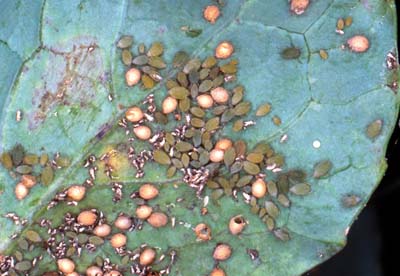To save the Web-optimized images shown below to your hard drive:
|
Click to access Display and Print quality images. |
Copyright © 2005 University of Florida
Vegetable crops that are commonly attacked include broccoli, Brussels sprouts, cabbage, cauliflower, collards, kale, kohlrabi, mustard, and turnip. The turnip aphid feeds mainly on the undersides of leaves and may feed on both sides of the leaf if high populations are present. Stems may also be fed upon and heavy infestations may cause plant death. Plant symptoms include stunting, yellowing of the foliage, and leaf cupping. The turnip aphid is capable of transmitting over 10 plant viruses. Plant populations that are present in the field may be determined by the use of sampling techniques such as sticky traps and water pans. Insecticides are commonly used to manage populations of the turnip aphid. Systemic and non-systemic insecticides are often applied at short intervals. Cultural control methods include host plant resistance and crop sanitation.
Images
To save the Web-optimized images shown below to your hard drive:

Turnip aphid, Lipaphis erysimi, colony on Brassica leaf with
many parasitized aphids or mummies.
(Photographer: J. Castner, University of Florida)
Click to access Display and Print quality images.
Copyright © 2005 University of Florida